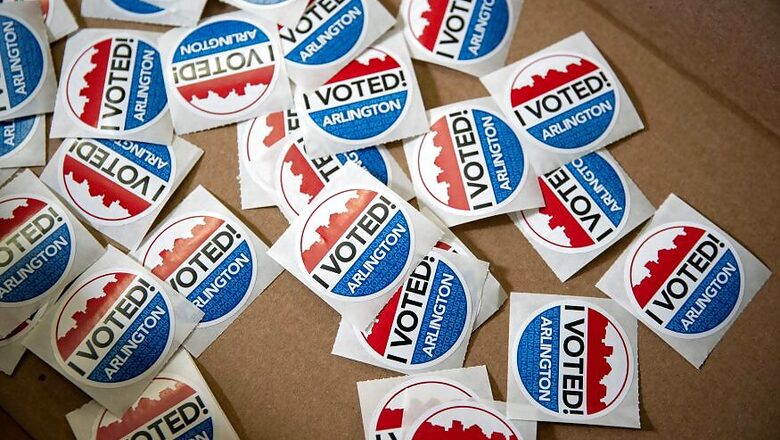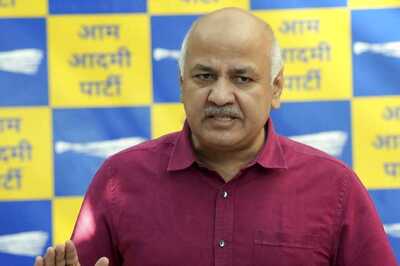
views
The U.S. presidential election will be decided by about a dozen states that could swing for either President Donald Trump, a Republican, or Democratic challenger Joe Biden.
These states will play a critical role in delivering the 270 electoral college votes needed to win the White House. Due to a surge in mail voting amid the coronavirus pandemic – as well the states’ varying rules for when ballots can be counted – the results may not be known on Election Day, Nov. 3.
FLORIDA
Electoral votes: 29
Polls close: 7 p.m. ET (Several counties in northwestern Florida are an hour behind the rest of the state.)
Rating in presidential contest: Toss-up
Other key races: Competitive U.S. House of Representative races in the 15th and 26th districts
Vote counting: Florida has no-excuse absentee voting. Election officials can begin scanning ballots more than three weeks before Election Day, but results cannot be generated until after polls closed. All ballots must be received by the close of polls on Election Day to be counted. However, ballots flagged for signature errors can be corrected until 5 p.m. on Nov. 5.
GEORGIA
Electoral votes: 16
Polls close: 7 p.m. ET
Rating in presidential contest: Toss-up
Other key races: Both U.S. Senate seats are up for grabs and considered competitive.
Vote counting: Georgia has no-excuse absentee voting. Ballots must be received by clerks by the close of polls on Election Day. Ballots can be opened and scanned upon receipt, but they cannot be tallied until after the polls close on Nov. 3.
NEW HAMPSHIRE
Electoral votes: 4
Polls close: 7 p.m. ET
Rating in presidential contest: Leans Democratic
Other key races: Governor Chris Sununu, a Republican, looks poised to win re-election.
Vote counting: New Hampshire state officials have said all voters are able to cast an absentee ballot if they have concerns about COVID-19, and the ballots must be received by 5 p.m. on Election Day. Ballots can be pre-processed in some jurisdictions beginning on Oct. 29, but not counted until the polls have closed on Nov. 3.
NORTH CAROLINA
Electoral votes: 15
Polls close: 7:30 p.m. ET
Rating in presidential contest: Toss-up
Other key races: Competitive governor and U.S. Senate contests
Vote counting: North Carolina has no-excuse absentee voting. Absentee ballots can be scanned weeks in advance, but results cannot be tallied before Election Day. Trump’s campaign has asked the U.S. Supreme Court to block the state’s plan to tally ballots that are postmarked by Nov. 3 and arrive by Nov. 12.
OHIO
Electoral votes: 18
Polls close: 7:30 p.m. ET
Rating in presidential contest: Toss-up
Other key races: Competitive U.S. House contest in the 1st District
Vote counting: Ohio has no-excuse absentee voting. Ballots can be scanned, but not tallied, as early as Oct. 6. Absentee ballots are the first to be counted on election night. Mailed ballots must be postmarked by Nov. 2 and received by 10 days after the Nov. 3 election to be counted.
MICHIGAN
Electoral votes: 16
Polls close: 8 p.m. ET
Rating in presidential contest: Leans Democratic
Other key races: Competitive U.S. Senate contest
Vote counting: Michigan has no-excuse absentee voting. Though there are ongoing legal challenges to change the rules, currently ballots must arrive at clerks’ offices by the close of polls on Election Day. Some densely populated jurisdictions in the state can open and sort absentee ballots beginning on Nov. 2, but the vast majority will not. Clerks can begin scanning and counting absentee ballots at 7 a.m. on Nov. 3.
PENNSYLVANIA
Electoral votes: 20
Polls close: 8 p.m. ET
Rating in presidential contest: Leans Democratic
Other key races: Competitive U.S. House contests in the 1st and 10th districts
Vote counting: Pennsylvania has no-excuse absentee voting, and ballot counting can begin at 7 a.m. on Election Day. The Pennsylvania Supreme Court ruled on Sept. 17 that officials in the state can accept mail-in ballots three days after the Nov. 3 election, so long as they were postmarked by Election Day.
TEXAS
Electoral votes: 38
Polls close: 8 p.m. ET (Two western counties in Texas are an hour behind the rest of the state.)
Rating in presidential contest: Leans Republican
Other key races: Competitive U.S. Senate contest
Vote counting: Texas voters must qualify to vote by mail, for example by being older than 65, being ill or disabled, or not being present in their voting county during the early voting period through Election Day. All voters can vote early in-person. The population of a county determines when election officials can pre-process and count mail ballots. If the county has more than 100,000 people, the ballots may be counted after polls close on the last day of in-person early voting in the state, which is Oct. 30. Ballots will still be counted if they are postmarked by Nov. 3 and received by 5 p.m. the day after the election. For military and overseas voters, that deadline is extended through the end of business on Nov. 9.
WISCONSIN
Electoral votes: 10
Polls close: 9 p.m. ET
Rating in presidential contest: Leans Democratic
Other key races: No governor or U.S. Senate races on the ballot
Vote counting: Wisconsin has no-excuse absentee voting. Ballots must be received by the close of polls on Election Day, and they cannot be counted until polls open on Nov. 3.
MINNESOTA
Electoral votes: 10
Polls close: 9 p.m. ET
Rating in presidential contest: Leans Democratic
Other key races: Competitive contests for the U.S. Senate and U.S. House in the 1st and 7th districts
Vote counting: Minnesota has no-excuse absentee voting, and ballots must be pre-processed within five days of receipt. Beginning on Oct. 20, ballots can be opened and logged, but the results are only tabulated after polls close on Election Day. Ballots will be counted so long as they are postmarked by Nov. 3 and received by Nov. 10.
ARIZONA
Electoral votes: 11
Polls close: 9 p.m. ET
Rating in presidential contest: Leaning Democratic
Other key races: Competitive U.S. Senate contest
Vote counting: Arizona has no-excuse absentee voting. All ballots must arrive by the close of polls on Election Day. Ballots can be scanned and tabulated starting 14 days before Nov. 3 but results not reported until after polls close on Election Day.
NEVADA
Electoral votes: 6
Polls close: 10 p.m. ET
Rating in presidential contest: Leans Democratic
Other key races: No governor or U.S. Senate contests on the ballot
Vote counting: Nevada has no-excuse absentee voting, and ballots can be processed upon receipt. Nevada officials will begin scanning and recording ballots 14 days before the election, but results are not released until election night. Ballots postmarked by Nov. 3 will be counted so long as they arrive within seven days after the election.
IOWA
Electoral votes: 6
Polls close: 10 p.m. ET
Rating in presidential contest: Toss-up
Other key races: Competitive U.S. Senate contest
Vote counting: Iowa has no-excuse absentee voting. The ballots must be received by the close of polls on Election Day, or by noon the following Monday if they are postmarked by Nov. 2. Election officials can begin opening ballot envelopes on the Saturday prior to the election and can begin scanning and tabulating them on Nov. 2.
Disclaimer: This post has been auto-published from an agency feed without any modifications to the text and has not been reviewed by an editor
Read all the Latest News and Breaking News here



















Comments
0 comment